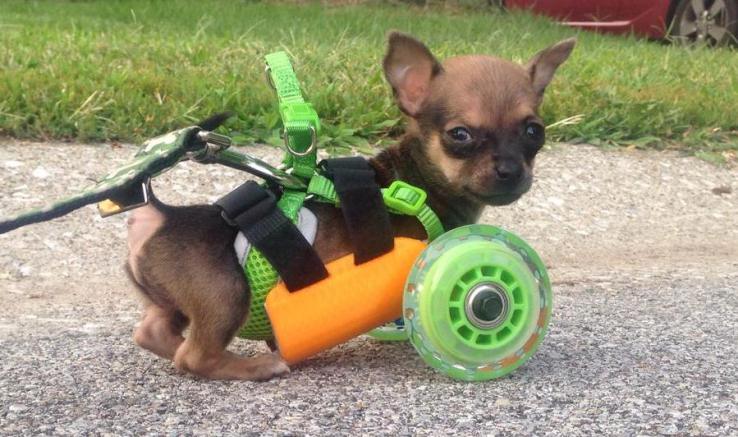
The process of 3D printing and 3D printable polymers like polylactic acid (PLA) are making the world a better place. 3D printing is being used to help people and animals all over the world.
Print and Roll
Turboroo, a Chihuahua, was born with no front legs. Thanks to 3D printing, and the know-how and generosity of Mark Deadrick, Turboroo can walk — or rather, roll. Deadrick, president of 3dyn, a California-based industrial design and manufacturing company, came across Turboroo’s call for help online. Deadrick designed a customized cart based on the photos provided on the site and added a set of rollerblade wheels. Turboroo can now roll along with his new high-tech “legs.”
The design was 3D-printed using a MakerBot Replicator 2, using PLA filament at 1.75mm. The PLA comes in many colors (even glow-in-the-dark). The cart took approximately four hours to print using a 30% fill volume (a honeycomb structure is created by the printer). If it were a solid piece, it could take about 10-12 hours to print. In addition to the fill volume, the layer thickness is adjustable (it was set at .20mm/layer (.008″ per layer) for the cart.
Deadrick told Polymer Solutions Newsblog:
We typically compare materials to aluminum, which would run under $4 a pound for fabrication, but is at least three times as dense, and traditional machining would make you start a large chunk of material, and remove what you don’t want. 3D printing, for the most part, adds material only where you need it.
A Lame Duck With Lots of Pluck
Buttercup the duck was born with a deformed foot, which would often get cut up as the duck walked, leaving him in pain. So Mike Garey, Buttercup’s caretaker from Feathered Angels Waterfowl Sanctuary in Arlington, Tennessee, took a veterinarian’s advice and opted to have the foot removed. Garey worked tirelessly to find an appropriate prosthetic for his feathered friend. The first model was made using a 3D-printed mold to create a silicone foot for buttercup. Buttercup was able to walk again and was quite happy with his new appendage.
Garey, however, was not thoroughly impressed with the design he had created. It had limitations in movement especially when swimming. He wanted Buttercup to have the most advanced prosthetic he could design so he could be like other ducks. Since his first design, new materials called flex filaments had entered the market for 3D printing. Flex filaments are made from thermoplastic elastomers (TPE) a class of copolymers. The TPE material offered more flexibility to his design, and Garey was able to create a prosthetic that closely resembled a real duck foot. After hundreds of hours and many designs later, Garey created his newest prosthetic design.
Click on the video below to see the design and printing of Buttercup’s new foot, and you can see firsthand how happy Buttercup is running around!
Fly Like an Eagle
Beauty, a bald eagle, was shot in the face, destroying the upper part of her beak. She was found foraging for food in at a dumpsite in Alaska, but due to the condition of her beak she was starving.
Jane Fink Cantwell, a medic at Birds of Prey Northwest near Coeur d’Alene, Idaho, took Beauty in and nursed her back to health. She tried to contact experts in the field for advice on how to save Beauty, but they all had the same answer: Euthanize Beauty since it was impossible to fix her beak. While teaching a class in Idaho, Cantwell met someone who thought he could help. That someone was Nate Calvin, founder of Kinetic Engineering Group. Calvin had no experience in the field but thought he could help Beauty.
Cantwell, Calvin, a team of wildlife experts, and even a dentist worked together to create a beak to help Beauty. They examined Beauty and even took X-rays of her head to customize a beak for her. After the design was completed, Calvin used a 3D printer to build the prosthetic beak. The new beak was made from a nylon-based polymer specifically designed for 3D printing.
After a two-hour surgical procedure to attach the beak, the team worked to tweak it by filing, adjusting and testing until it finally worked. After the surgery Beauty could do the things a normal eagle could do, like groom herself and drink water.
Endless Possibilities
These are just a few of the amazing stories of how 3D printing has changed our world. The possibilities are endless as to what can be accomplished with this new and innovative technology. With the emergence of 3D printing technology, we’re now thinking outside the cube.
Image by Downtown Pet Vet | Mark Deadrick.
Video: “Buttercup the Duck’s New Foot Is Printed on a 3D Printer and He Walks & Runs!” by Feathered Angels Sanctuary, YouTube.com.
Source: “TurboRoo, The Chihuahua With No Front Legs, Can Walk Again Thanks To 3D Printing,” by John Biggs, www.techcrunch.com, August 8, 2014.
Source: “Buttercup the Duck Gets Brand New 3D Printed Foot,” by Alan Gardner, www.3dprint.com, February 24, 2014.
Source: “Beauty the Bald Eagle Gets a New 3D Printed Beak,” by Brooke Kaelin, www.3dprinterworld.com, July 14, 2013.
